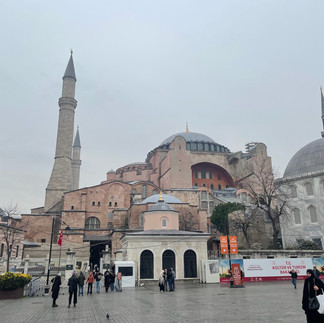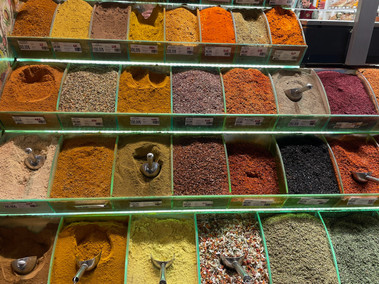东游记活动|Istanbul: East and West at the Cross Roads 伊斯坦布尔:东西方的十字路口
- Ole Bouman
- Mar 22, 2024
- 6 min read
Journey to the East event in Istanbul, Turkey, March 7
3月7日于土耳其伊斯坦布举办第三场“东游记”活动

Journey to the East cycling project is an attempt to map, understand and reflect upon the cultural axis of East and West, as perhaps the most lasting generator of global history and creative drive. Cycling this axis goes further though. From an intellectual discourse, this time the axis can be experienced as an immediate reality, being embodied by real situations in time and space, and real people living their lives before and beyond reflection. This is literally about leaving any proverbial armchair, and act with a profound physical effort and risk, going beyond any theory in favor of evidence, evidence, and nothing but evidence.
"东游记"骑行项目是一次尝试,旨在绘制、理解并深思东西方的文化轴线,这轴线或许是全球历史和创新动力最持久的源泉。在这一轴线上骑行的意义远不止此。它将智识讨论转变为直接体验,让人通过时间与空间的真实情境、真人真事的生活状态去亲身感受,而非单纯的反思。这实际上意味着离开安逸的扶手椅,以深切的体力付出和冒险精神行动起来,追求的是实证,只有实证,除了实证,别无他求。
To break down this ongoing action of many months in a row into smaller acts, there will be held several events, marking about any 1000km or so. Each of them will address a specific dimension of the East West relationship, intended to capture insights more precisely, to establish connections, and to generate a physical legacy to be taken on the journey towards final destination Shanghai, where a group of students will start working on a tangible conclusion of the journey.
为了将这一持续多月的连续行动分解为更小的行为单位,我们将举办一系列事件,每骑行约1000公里便标记一次。每个事件都将聚焦东西方关系的一个特定层面,以求更精确地捕捉洞见,建立联系,并为这一旅程创造物质遗产,随行至终点上海。在那里,一群学生将会对这一旅程作出具体结论。
The series' third event unfolded in Istanbul, a city that for millennia has been contested as belonging to… Yes to whom?
这个系列的第三场活动在伊斯坦布尔展开,一个几千年来一直被争夺归属的城市……是的,归属于谁呢?
Not only has the city been changing hands a number of times, as a trophy of dominant powers. Changes also caused entire paradigm shifts, determining global history for centuries, profoundly directing regional developments, framing world views, belief systems, and ideologies, and upholding its reputation of being not only a strategic stronghold, foothold or bulwark, but also a symbol of civilizational might. Rulers did not only want to be in charge of Istanbul, they defined it as being power itself, the core of legitimacy, a true source and generator of culture. Moreover, this role and capacity of Istanbul did not only lead to a series of superpositions, but managed to blend old and new, secular and spiritual, and even Europe and Asia. The answer to the question therefore should be: “to everyone”, a model of kosmopolitanism.
这座城市的易手不仅仅是作为统治力量的象征,更多次见证了深刻的历史变革,这些变革不仅塑造了几个世纪的全球历史,也深刻指导了区域发展,影响了世界观、信仰体系及意识形态,并确立了其作为战略要塞、立足之地或是防御工事之外的文明力量象征的地位。统治者们追求的不仅是对伊斯坦布尔的控制,他们将其视为权力的化身,合法性的核心,文化的真正源泉和创造者。伊斯坦布尔的角色和能力不仅引领了文化的重叠与融合,更成功地结合了古与今、世俗与灵性,以及欧洲与亚洲的特质。因此,对于这个问题,答案应该是“对每个人”,它是一种全球主义的模范。
Istanbul’s geographic unique position has given it a special relationship with the water of Bosporus and Marmara Sea. At moments, it looks as if the entire city deals with the water, by crossing the many bridges, by having a meal along the waterfront, by fishing on the Galata bridge or by just watching Marmara from deck chairs along the sea.
伊斯坦布尔地理位置的独特性赋予了它与博斯普鲁斯海峡和马尔马拉海的特殊关系。有时候,整个城市似乎都在与水打交道,不管是穿越众多的桥梁,还是在海滨用餐,或是在加拉塔桥上钓鱼,抑或仅仅是坐在海边的躺椅上观看马尔马拉海。
Arriving in Istanbul, my very first thing to do is to climb the hill towards Topkapi Palace and Hagia Sophia, monuments that uniquely embody the spirit of Istanbul of mixing cultures and the power of art stronger than any violent inclination to destroy. This church, turned into mosk, has the grandeur of any architecture that vindicates its status as Mother of all Arts.
到达伊斯坦布尔,我的首要之事便是攀登至托普卡普宫和圣索菲亚大教堂的山丘之上。这些历史遗迹独特地展现了伊斯坦布尔融合文化的精神和艺术的力量,这种力量比任何破坏性的冲动都要强大。这座从教堂转变为清真寺的建筑,以其建筑的宏伟彰显了其作为所有艺术之母的地位。
Roaming the Grand and Egyptian Bazaar facilitates to get in actual touch with the Silk Road history, making Istanbul a true cross roads of trade, taste, desire and temptation. Here it becomes clear what it means to bring the world together in terms of its cultural and material riches.
在大巴扎和埃及巴扎闲逛,可以直接体验到丝绸之路的历史,令伊斯坦布尔成为了贸易、风味、欲望与诱惑交汇的真正十字路口。这里生动地展示了如何将世界的文化与物质财富汇集于一地的深刻含义。
Way before modern Türkiye, way before the Ottoman Empire, way before Constantinople, there was a Byzantium that was visited by Roman emperors and dignitaries as a place worth traveling all across the Balkan to exert power and authority. For them a special Golden Gate was built. It’s still there.
早在现代土耳其、奥斯曼帝国乃至君士坦丁堡的时代之前,就有一个被罗马皇帝和贵族视为值得穿越巴尔干半岛前来施展权力与威望之地的拜占庭。为了迎接他们,特地建造了一座金门。这座门至今犹在。

And the event at the Art Istanbul Feshane former Fez factory, hosted wonderfully by Mustafa Osman, an encounter was staged between my threefold motivation to embark on this journey, and the curiosity from the audience, asking me several questions. For the first time this project, I felt that motivation is no longer enough. What is in people’s mind is what makes the difference. Whatever effort to prepare my visits, I am exposed to knowledge, vision and sentiments that cannot be anticipated from afar.
在艺术伊斯坦布尔费什哈内前菲兹帽工厂举行的活动中,由穆斯塔法·奥斯曼精心策划,我的旅行的三重动力与观众的浓厚兴趣碰撞,引发了一场深刻的对话。观众提出的种种问题让我首次意识到,单靠动机是不够的。是人们心里的思考和问题,才真正让这次旅行与众不同。不管我如何准备访问,总会遇到那些从未预料到的知识、见解和情感,这些都是从远处无法预见的。


It can’t be left unmentioned how the the president of the Turkish Cycling Association Murat Suyabatmaz attended the lecture, offered me help to cross Türkiye, and most of all wanted to test my bicycle which reputation apparently is growing.
值得一提的是,土耳其自行车协会主席Murat Suyabatmaz参加了我的讲座,并提出帮助我穿越土耳其的建议。更为重要的是,他还表示想要亲自试骑我的自行车,这辆车的名声显然正在逐渐增长。
Journey to be continued...
and to follow the Journey by
Instagram:@Olebouman
Linkedin:@Olebouman
Facebook:@Olebouman
Youtube: @Journey to the East
Linktree: https://linktr.ee/olebouman
Weibo:@Olebouman










































Comments